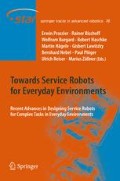Abstract
In order to behave intelligently, artificial agents must be able to deliberatively plan their future actions. Unfortunately, realistic agent environments are usually highly dynamic and only partially observable, which makes planning computationally hard. For most practical purposes this rules out planning techniques that account for all possible contingencies in the planning process. However, many agent environments permit an alternative approach, namely continual planning, i. e. the interleaving of planning with acting and sensing.
This article presents a principled approach to continual planning that describes why and when an agent should switch between planning and acting. The resulting continual planning algorithm enables agents to deliberately postpone parts of their planning process and instead actively gather missing information that is relevant for the later refinement of the plan. To this end, the algorithm explictly reasons about the knowledge (or lack thereof) of an agent and its sensory capabilities. In order to enable proactive information gathering we introduce the concept of assertions into our planning language, i.e. abstract actions that can substitute yet unformed subplans in early planning phases.
To study our continual planning approach empirically we have developed MAPSIM, a simulation environment that automatically builds multiagent simulations from planning domain descriptions. In MAPSIM, agents can thus not only plan, but also execute their plans, perceive their environment, and interact with each other.While obviously such a simulation does not capture many aspect of a physical robot environment, it can be used for rapid prototyping of planning models for such environments.
Access this chapter
Tax calculation will be finalised at checkout
Purchases are for personal use only
Preview
Unable to display preview. Download preview PDF.
References
Ambros-Ingerson, J.A., Steel, S.: Integrating planning, execution and monitoring. In: Proc. AAAI 1988, Saint Paul, MI, pp. 83–88 (August 1988)
Bäckström, C.: Computational aspects of reordering plans. JAIR 9, 99–137 (1998)
Bonet, B., Geffner, H.: Planning with incomplete information as heuristic search in belief space. In: Proceedings of the 5th International Conference on Artificial Intelligence Planning Systems (AIPS 2000), pp. 52–61. AAAI Press, Menlo Park (2000)
Brenner, M., Nebel, B.: Continual planning and acting in dynamic multiagent environments. Journal of Autonomous Agents and Multiagent Systems 19(3), 297–331 (2009)
DesJardins, M., Durfee Jr., E., Ortiz, C., Wolverton, M.: A survey of research in distributed, continual planning. The AI Magazine 20(4), 13–22 (1999)
Erol, K., Hendler, J., Nau, D.: Complexity results for hierarchical task-network planning. Annals of Mathematics and Artificial Intelligence 18, 69–93 (1996)
Etzioni, O., Golden, K., Weld, D.S.: Sound and efficient closed-world reasoning for planning. Artificial Intelligence 89(1-2), 113–148 (1997)
Etzioni, O., Hanks, S., Weld, D., Draper, D., Lesh, N., Williamson, M.: An approach to planning with incomplete information. In: Proc. KR 1992, pp. 115–125 (1992)
Golden, K.: Leap before you look: Information gathering in the puccini planner. In: Proc. AIPS 1998, pp. 70–77 (1998)
Golden, K., Weld, D.: Representing sensing actions: The middle ground revisited. In: Proc. KR 1996 (1996)
Hoffmann, J., Brafman, R.: Contingent planning via heuristic forward search with implicit belief states. In: Biundo, S., Myers, K.L., Rajan, K. (eds.) ICAPS, pp. 71–80. AAAI (2005)
Knoblock, C.A.: Planning, executing, sensing, and replanning for information gathering. In: Mellish, C. (ed.) Proceedings of the Fourteenth International Joint Conference on Artificial Intelligence, pp. 1686–1693. Morgan Kaufmann, San Francisco (1995)
Levesque, H.J.: What is planning in the presence of sensing? In: Proc. AAAI 1996, pp. 1139–1146. MIT Press (July 1996)
Meyer, B.: Applying ”Design by Contract”. Computer 25, 40–51 (1992)
Nau, D., Cao, Y., Lotem, A., Munoz-Avila, H.: SHOP: Simple hierarchical ordered planner. In: Dean, T. (ed.) Proceedings of the 16th International Joint Conference on Artificial Intelligence (IJCAI 1999), Stockholm, Sweden, August 1999. Morgan Kaufmann (1999)
Nau, D.S., Au, T.-C., Ilghami, O., Kuter, U., William Murdock, J., Wu, D., Yaman, F.: Shop2: An htn planning system. JAIR 20, 379–404 (2003)
Petrick, R., Bacchus, F.: A knowledge-based approach to planning with incomplete information and sensing. In: Proc. AIPS 2000 (2002)
Petrick, R.P.A., Bacchus, F.: Extending the knowledge-based approach to planning with incomplete information and sensing. In: Proc. ICAPS 2004, pp. 2–11 (2004)
Rintanen, J.: Complexity of planning with partial observability. In: Proc. ICAPS 2004, pp. 345–354 (2004)
Russell, S., Norvig, P.: Artificial Intelligence: A Modern Approach, 2nd edn. Prentice-Hall, Englewood Cliffs (2003)
Thiebaux, S., Hoffmann, J., Nebel, B.: Defense of axioms in PDDL. In: Proc. IJCAI (2003)
Weld, D.S., Anderson, C.R., Smith, D.E.: Extending graphplan to handle uncertainty and sensing actions. In: AAAI/IAAI, pp. 897–904 (1998)
Yang, Q.: Intelligent Planning: A decomposition and abstraction based approach. Springer, Heidelberg (1997)
Yokoo, M., Hirayama, K.: Algorithms for distributed constraint satisfaction: a review. Autonomous Agents and Multi-Agent Systems 3(2) (2000)
Author information
Authors and Affiliations
Corresponding author
Editor information
Editors and Affiliations
Rights and permissions
Copyright information
© 2012 Springer-Verlag GmbH Berlin Heidelberg
About this chapter
Cite this chapter
Brenner, M., Nebel, B. (2012). Proactive Continual Planning –. In: Prassler, E., et al. Towards Service Robots for Everyday Environments. Springer Tracts in Advanced Robotics, vol 76. Springer, Berlin, Heidelberg. https://doi.org/10.1007/978-3-642-25116-0_7
Download citation
DOI: https://doi.org/10.1007/978-3-642-25116-0_7
Published:
Publisher Name: Springer, Berlin, Heidelberg
Print ISBN: 978-3-642-25115-3
Online ISBN: 978-3-642-25116-0
eBook Packages: EngineeringEngineering (R0)

